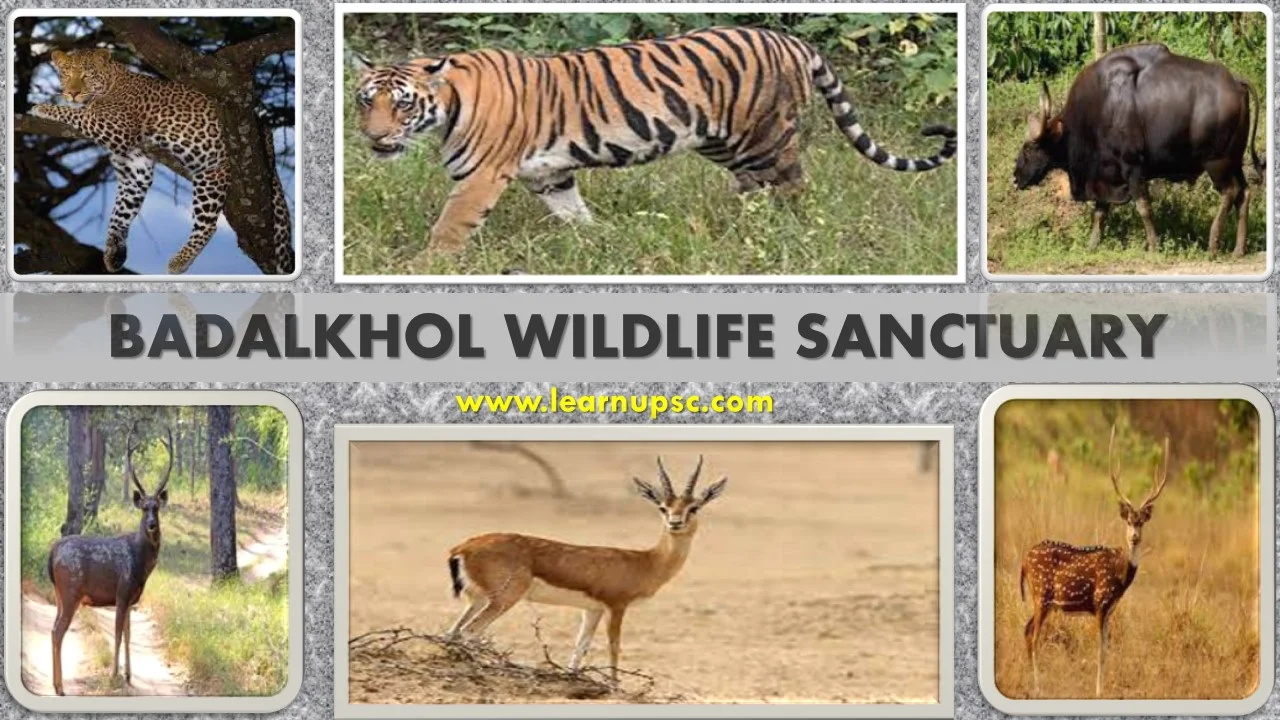Badalkhol Wildlife Sanctuary UPSC
The Badalkhol Wildlife Sanctuary is a protected area located in the state of Chhattisgarh, India. This sanctuary was once the hunting ground of the Jashpur Maharaj, the ruler of the region. The sanctuary is characterized by its hilly terrain, dense forests, and catchment area for the Ib and Dodki rivers.
Within the sanctuary's boundaries, there are four forest villages with around 118 families, with approximately 90 percent belonging to scheduled castes and tribes.
|
Table of Contents
|
Badalkhol Wildlife Sanctuary Location
The Badalkhol Wildlife Sanctuary is located in the Jashpur district of the central Indian state of Chhattisgarh. It is situated at a distance of approximately 90 kilometers from the district headquarters.
Nearest Airport:
The nearest airport to the Badalkhol Wildlife Sanctuary is the Swami Vivekananda Airport in Raipur. The Swami Vivekananda Airport is the primary airport serving the state of Chhattisgarh and is located in the capital city, Raipur, which is approximately 315 kilometers from Jashpur.
Nearest Railway Station:
The nearest railway station is Raigarh Railway Station, which is situated about 165 kilometers away from the sanctuary.
Badalkhol Wildlife Sanctuary History
1. Former Hunting Ground of Jashpur Maharaj: The Badalkhol Wildlife Sanctuary in Chhattisgarh, India, has a historical background as it once served as the hunting ground of the Jashpur Maharaj, the local ruler of the region. In the past, the area was used for hunting and tracking wild animals by the Maharaj and his companions.
2. Establishment as a Wildlife Sanctuary: With the increasing awareness of the importance of wildlife conservation and the need to protect natural habitats, the Badalkhol area was designated as a wildlife sanctuary. In 1975, the Indian government officially established the Badalkhol Wildlife Sanctuary to safeguard the diverse flora and fauna found in the region.
Badalkhol Wildlife Sanctuary Area
The Badalkhol Wildlife Sanctuary covers a total area of approximately 104.454 square kilometers.
Badalkhol Wildlife Sanctuary River
The entire area of the Badalkhol Wildlife Sanctuary is the catchment area of two rivers: the Ib River and the Dodki River. These rivers play a crucial role in shaping the sanctuary's ecosystem and supporting the diverse flora and fauna found in the region.
Badalkhol Wildlife Sanctuary Flora
The Badalkhol Wildlife Sanctuary is blessed with a rich and diverse flora. The sanctuary's varied ecosystems, including hills, rivers, and forests, support a wide range of plant species. Some of the prominent flora found in the sanctuary are as follows:
Teak (Tectona grandis): Teak forests are a common sight in the sanctuary. Teak is a valuable timber tree known for its durable wood and is widely used in various industries.
Sal (Shorea robusta): The sanctuary also features Evergreen Sal Forests, with Sal being one of the dominant tree species in the region. Sal is an important hardwood tree and contributes significantly to the ecosystem.
Saja (Terminalia elliptica): Saja is a deciduous tree commonly found in the sanctuary's forests.
Dhawda (Anogeissus latifolia): Dhawda is another deciduous tree species present in the region.
Salai (Boswellia serrata): Salai is a tree known for its aromatic resin and is also part of the sanctuary's vegetation.
Bija (Pterocarpus marsupium): Bija, or Indian Kino Tree, is a species of legume tree found in the sanctuary.
Khamhar (Butea monosperma): Khamhar, also known as Flame of the Forest, is a flowering tree adding color to the sanctuary's landscapes.
Haldu (Adina cordifolia): Haldu is a deciduous tree with medicinal properties that is found in the sanctuary.
Arjun (Terminalia arjuna): Arjun is a tree known for its medicinal properties and is found in the region.
Mahuha (Madhuca longifolia): Mahuha is a tree species known for its edible fruits and oil-rich seeds.
Tendu (Diospyros melanoxylon): Tendu is a deciduous tree whose leaves are used for making traditional Indian beedi cigarettes.
Amla (Phyllanthus emblica): Amla, or Indian Gooseberry, is a small tree with numerous medicinal uses.
Char (Buchanania lanzan): Char is a tree species known for its edible nuts.
Tinsa (Ougeinia oojeinensis): Tinsa is a deciduous tree found in the sanctuary.
Karra (Cleistanthus collinus): Karra is a tree species with toxic properties.
Landiya (Lannea coromandelica): Landiya is a deciduous tree commonly seen in the sanctuary.
Badalkhol Wildlife Sanctuary Fauna (Badalkhol Wildlife Sanctuary Animals)
The Badalkhol Wildlife Sanctuary is home to a diverse array of fauna, including various species of mammals, birds, and other wildlife. The sanctuary's protected status and varied ecosystems provide a conducive environment for these animals to thrive. Here are some of the notable fauna found in the Badalkhol Wildlife Sanctuary:
Mammals:
- Indian Gazelle (Chinkara)
- Bison (Gaur)
- Sambar
- Spotted Deer (Chital)
- Hyena
- Chausingha (Four-horned Antelope)
- Jackal
- Nilgai (Blue Bull)
- Wild Boar
- Leopard
- Tiger
Birds:
- Stork
- Peacock
- Rock Pigeon
- Parrot
- Quail
Reptiles:
- Indian Python
- Common Cobra
- Russell's Viper
- Rat Snake
- Monitor Lizard
- Fan-throated Lizard
Badalkhol Wildlife Sanctuary UPSC Questions
Q. Where is Badalkhol Wildlife Sanctuary?
A. The Badalkhol Wildlife Sanctuary is located in the Jashpur district of the state of Chhattisgarh, India. Jashpur district is situated in the northern part of Chhattisgarh, bordering the states of Jharkhand and Odisha.


No comments:
Post a Comment